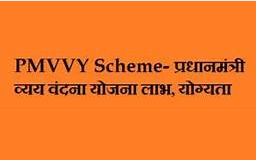Initially an assured rate of return of 7.40 % per annum for the year 2020-21 per annum will be provided and thereafter to be reset every year.
PMVVY Scheme Extention: The Union Cabinet has approved extension of ‘Pradhan Mantri Vaya Vandana Yojana’ (PMVVY) up to 31st March 2023 for a further period of three years, beyond 31st March 2020. Earlier, the last date of PMMVY was March 31, 2020, and the extension was not provided to it. Now, the last date to invest in PMVVY will be March 31, 2023.
As per the tweet of the Director-General, Press Information Bureau, the extension of PMVVY will enable old age income security and welfare of senior citizens. The extension of PMVVY scheme will help senior citizens as the entry age in the scheme is 60 years. In a falling interest rate scenario, a fixed return of around 8 per cent with high safety of capital is what PMVVY has to offer to investors. To invest in PMVVY, one needs to approach LIC as it is the sole institution allowed by the government to offer the plan, both online and offline.
Also Read:Kisan Vikas Patra (KVP) is a safe medium of investment, important things to know about it
The new rules will be as follows:
- To allow initially an assured rate of return of 7.40 % per annum for the year 2020-21 per annum and thereafter to be reset every year.
- Annual reset of assured rate of interest with effect from April 1st of financial year in line with revised rate of returns of Senior Citizens Saving Scheme (SCSS) upto a ceiling of 7.75% with fresh appraisal of the scheme on breach of this threshold at any point.
- Approval for expenditure to be incurred on account of the difference between the market rate of return generated by LIC (net of expenses) and the guaranteed rate of return under the scheme.
- Capping Management expenses at 0.5% p.a. of funds of the scheme for first year of scheme in respect of new policies issued and thereafter 0.3% p.a. for second year onwards for the next 9 years.
- Delegating the authority to Finance Minister to approve annual reset rate of return at the beginning of every financial year


